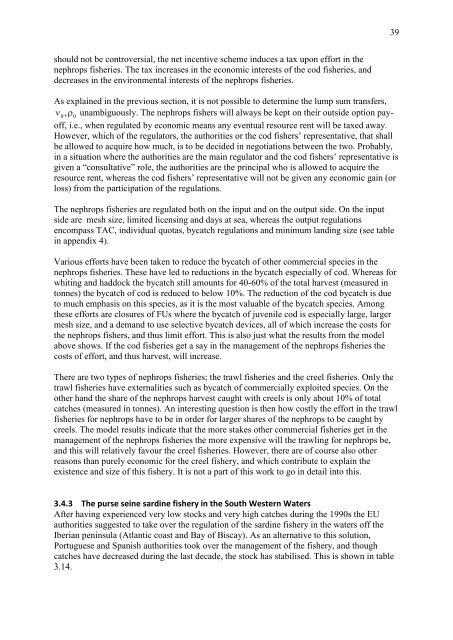Operational tools and adaptive management
Operational tools and adaptive management
Operational tools and adaptive management
Create successful ePaper yourself
Turn your PDF publications into a flip-book with our unique Google optimized e-Paper software.
should not be controversial, the net incentive scheme induces a tax upon effort in the<br />
nephrops fisheries. The tax increases in the economic interests of the cod fisheries, <strong>and</strong><br />
decreases in the environmental interests of the nephrops fisheries.<br />
As explained in the previous section, it is not possible to determine the lump sum transfers,<br />
0, 0 unambiguously. The nephrops fishers will always be kept on their outside option payoff,<br />
i.e., when regulated by economic means any eventual resource rent will be taxed away.<br />
However, which of the regulators, the authorities or the cod fishers‟ representative, that shall<br />
be allowed to acquire how much, is to be decided in negotiations between the two. Probably,<br />
in a situation where the authorities are the main regulator <strong>and</strong> the cod fishers‟ representative is<br />
given a “consultative” role, the authorities are the principal who is allowed to acquire the<br />
resource rent, whereas the cod fishers‟ representative will not be given any economic gain (or<br />
loss) from the participation of the regulations.<br />
The nephrops fisheries are regulated both on the input <strong>and</strong> on the output side. On the input<br />
side are mesh size, limited licensing <strong>and</strong> days at sea, whereas the output regulations<br />
encompass TAC, individual quotas, bycatch regulations <strong>and</strong> minimum l<strong>and</strong>ing size (see table<br />
in appendix 4).<br />
Various efforts have been taken to reduce the bycatch of other commercial species in the<br />
nephrops fisheries. These have led to reductions in the bycatch especially of cod. Whereas for<br />
whiting <strong>and</strong> haddock the bycatch still amounts for 40-60% of the total harvest (measured in<br />
tonnes) the bycatch of cod is reduced to below 10%. The reduction of the cod bycatch is due<br />
to much emphasis on this species, as it is the most valuable of the bycatch species. Among<br />
these efforts are closures of FUs where the bycatch of juvenile cod is especially large, larger<br />
mesh size, <strong>and</strong> a dem<strong>and</strong> to use selective bycatch devices, all of which increase the costs for<br />
the nephrops fishers, <strong>and</strong> thus limit effort. This is also just what the results from the model<br />
above shows. If the cod fisheries get a say in the <strong>management</strong> of the nephrops fisheries the<br />
costs of effort, <strong>and</strong> thus harvest, will increase.<br />
There are two types of nephrops fisheries; the trawl fisheries <strong>and</strong> the creel fisheries. Only the<br />
trawl fisheries have externalities such as bycatch of commercially exploited species. On the<br />
other h<strong>and</strong> the share of the nephrops harvest caught with creels is only about 10% of total<br />
catches (measured in tonnes). An interesting question is then how costly the effort in the trawl<br />
fisheries for nephrops have to be in order for larger shares of the nephrops to be caught by<br />
creels. The model results indicate that the more stakes other commercial fisheries get in the<br />
<strong>management</strong> of the nephrops fisheries the more expensive will the trawling for nephrops be,<br />
<strong>and</strong> this will relatively favour the creel fisheries. However, there are of course also other<br />
reasons than purely economic for the creel fishery, <strong>and</strong> which contribute to explain the<br />
existence <strong>and</strong> size of this fishery. It is not a part of this work to go in detail into this.<br />
3.4.3 The purse seine sardine fishery in the South Western Waters<br />
After having experienced very low stocks <strong>and</strong> very high catches during the 1990s the EU<br />
authorities suggested to take over the regulation of the sardine fishery in the waters off the<br />
Iberian peninsula (Atlantic coast <strong>and</strong> Bay of Biscay). As an alternative to this solution,<br />
Portuguese <strong>and</strong> Spanish authorities took over the <strong>management</strong> of the fishery, <strong>and</strong> though<br />
catches have decreased during the last decade, the stock has stabilised. This is shown in table<br />
3.14.<br />
39

















